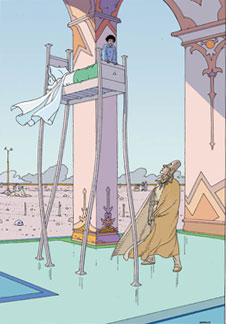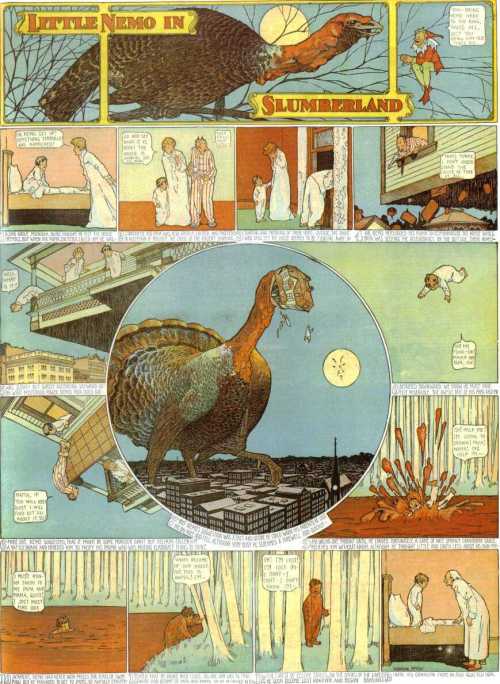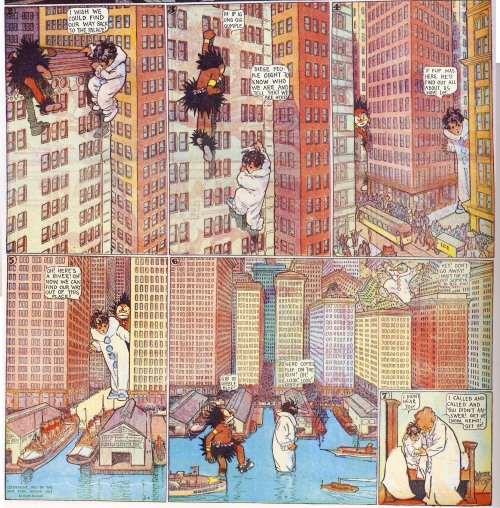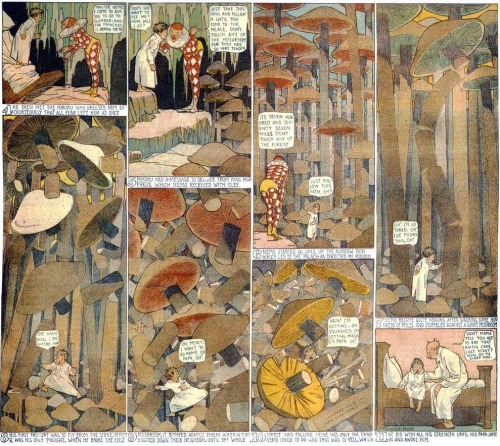Note: This is the third in a series of essays written by the current Class of 2012 for Survey of the Drawn Story I, CCS’s comics history class. They are posted here in approximate chronological order of when their chosen subjects—comic strips—were either first published, or in their heyday.
These were class assignments, and should be enjoyed in that context; these are not necessarily indicative of the work the individual artists/writers would do in paid professional venues. This is work assigned in class with a tight deadline, completed while juggling many other class assignments. That said, it is all of high caliber, or we would not be sharing it with you here. Enjoy!
All illustrations and captions in this particular post were incorporated into the original essay by its author, Bill Bedard. Bill also prepared them all for this online posting; thanks, Bill! Unless otherwise noted, any images accompanied by captions or comments in brackets [like this] were added by the Survey I instructor, Stephen Bissette, to enhance this public post, as were the author info and “further reading” notes after the essay and author’s footnotes.
________________________________________________
Little Nemo in Slumberland
by Bill Bedard
Little Nemo in Slumberland by Winsor McCay is a masterful work. Published Sundays off and on from 1905-27, the strip follows the adventures of a tousle-haired boy in his dreams. The boy, Nemo, first spends his time in dreams attempting to reach Slumberland to be the playmate of the Princess, daughter of King Morpheus of Slumberland. In later strips, having achieved his goal and reached the princess, the strip follows the antics of Nemo and friends through the madcap and surreal landscapes of Slumberland. McCay’s work was ground breaking at the time, and nearly a century later still considered to be a perfect example of what potential for excellence the comics medium holds.
While Little Nemo has ignited the imagination of many artists to chronicle their own dreamlands, some successful contemporary artists look back on Nemo with a critical eye, taking umbrage with McCay’s lines or the attention lavished upon the surreal landscapes at the expense of the characters. These criticisms are to a degree very valid, but must be considered not only in the framework of a single Sunday page, but as an ongoing part of thousands of single stories that work together to tell a narrative. In this way, a character like Nemo, who may appear flat may in fact be a multifaceted hero whose character and personality is simply divulged over a course of months and years.
Nemo’s bed goes for a walk; 1905, The New York Herald.
_____
Finding Fault with Nemo
One of the most common criticisms that Little Nemo receives is that Slumberland, along with all the other fantastical dream lands that are visited in Nemo, including the North Pole and Mars, are treated with more deference than the human/dream beings are afforded. Bill Waterson of Calvin and Hobbes fame lamented in an article:
“To be perfectly honest, however I admire Little Nemo more than I actually like it. McCay was clearly more interested in his stage than in his actors, and a stage, no matter how grand, can’t carry a play. The inventive visual effects notwithstanding, I can’t read the strip without thinking how much more enchanting Slumberland would be if the characters, rather than the backdrops and costumes, advanced the story.”
Watterson called the characters “cardboard dressup dolls” and cited the word balloons done by McCay as evidence that story was a pale second in comparison with the design of the world itself. He pointed out that the balloons tend to seem like a squished in afterthought- not part of the page design until the eleventh hour. Watterson also noted that dialogue generally fails to use characters’ voice as a way to describe them. He excluded Flip Flop the clown from this generality, but Nemo and the rest had nothing but “flat, exclamatory dialogue or overuse of exposition.”
In this strip from the NY Herald, Thanksgiving Day 1905, Nemo doesn’t say anything in word balloons that doesn’t rehash the captions or end up as a call for his mother or father. This doesn’t stop the strip from being an ingenius reversal of who normally gobbles whom on Turkey Day. The title panels and page design on the whole are excellently crafted, and even the celery stalk forest mirrors the white verticals of the nightshirts in the upper panels.
In this sequence from 1905 in the NY Herald, Nemo and the Imp are lost as giants in a city. The dialogue balloons do not actually mirror the action, but still may feel as if they were put in as “afterthoughts” by McCay, due to the their organic and “smooshed” look.
______________
Measuring Up to the Environment
In some cases Watterson and others’ claims are certainly true, and the interaction and dialogue between Nemo, Flip and other denizens of Slumberland appears flat in comparison to the charm and personality that Slumberland itself can affect during the course of a Sunday strip.
However, a close examination of McCay’s work as a whole reveals a variety of personality and growth for the main characters. Nemo’s own reticent nature may have been a purposeful choice on the part of McCay.
Richard Marschall, editor of The Best of Little Nemo in Slumberland, wrote in his introduction to that book that Nemo’s name, the Latin translation of which is “No-One,” may actually have been a conscious decision to keep the main character as bland or passive as possible. According to Marschall, Nemo is the “every-man dreamer” who corresponds to the reader. Famed illustrator Maurice Sendak wrote of Nemo that one reason for his quietude and reticence during the journeys through Slumberland is that “Nemo lacks savior-faire. He is naive and as simple and straightforward as apple pie.”
Descriptions of McCay’s characters as one-dimensional suggest readings of McCay’s work as single pages instead of as parts of a larger narrative whole. Nemo isn’t passive to the actions of Slumberland and supporting cast. Flip, the main antagonist and later a sort of “buddy” for Nemo may jump off the page at times with his zany jealousy and rivalries, but Nemo grows into his role as Slumberland explorer.
Sendak actually laments one of the ways in which Nemo grows into his character, where Nemo and Flip come to blows, and Nemo wins. Sendak wrote: “A sad victory: Nemo exchanges childhood for manhood, never thinking he might have both.”
Even in strips sans Flip, where Nemo plays off the Princess or a missive from Morpheus, his own personality comes through. In the case of Somnus, the horse he is given to arrive in Slumberland, Nemo is challenged to a race and lets his pride get the best of him—he is thrown off the horse and lands in bed. (1904, NY Herald)
A second example is the moment where Nemo, overwhelmed by his desire for the beautiful Queen Crystalite, takes her in his arms in a big kiss and breaks her into a million pieces. (1906, NY Herald)
_______
While these emotive experiences do seem to fit in Sendak’s assertion that Nemo is perhaps exchanging his boyhood for manhood, Nemo’s personality does not seem to be permanently altered by the strips. The next Sunday, he is back to be being an unsure and cautious dreamer in a world which, many times, turns dangerous at any moment. These moments of assertive (and usually wrong-headed) “adultness” combined with his passivity and fearful approach as a child in a dangerous dreamworld serve to make Nemo a complete whole, instead of a onedimensional character who serves as a foil for the Slumberland and Flip. Just as dreams can have the dreamer childlike and afraid one night and aggressive the next, McCay allows Nemo the full range of possibilities.
Above and below: Three examples from the NY Herald of Nemo being his non-character “coward” self afraid of an ogre, and then more expressive, five years later in an adventure on Mars.
It’s Not All “Agout” Nemo
Nemo isnt’ the only character who blossoms with a more complete reading of the work. Secondary characters evolve and change with the plot as well, as is the case when the brooding and wise Morpheus gets painful gout (NY Herald, 2 Jan, 1910) or later Nemo strips when the Princess and Nemo engage in play dates and get into trouble. Being secondary characters, they still aren’t as fully fleshed out as Nemo and Flip, but having them change means they are more than just the “brooding king” and “lonely princess” archetypes they seem at first brush.
Gouty Morpheus, NY Herald, 2 Jan, 1910
________
Hidden in Plain Sight
What critics of the strip often forget is that Nemo, Flip and the denizens of Slumberland aren’t the only characters in McCay’s works. Slumberland itself is as much a character as any of the actors on its stage. When the strip was reinvented under a different name because of legal issues with the publisher owning the rights to the name of Little Nemo in Slumberland the strip name didn’t even include “Nemo.” Instead, it was penned as In the Land of Wonderful Dreams. Later, when the rights reverted and the strip was rebooted in the 1920s Nemo’s appellation did return. However, during the most popular Nemo strips (those taking place from 1908-1912) a main driving force behind action and narrative isn’t just the titular boy, it’s the world in which he finds himself.
In Slumberland’s case many of the events that happen to normal comic book heroes, such as growth, change, conflict and resolution are present (sadly, most often the resolution for Slumberland is that the place falls to pieces or melts as a result of sunlight and deposits Nemo back into consciousness).
In a typical Slumberland scene, Nemo is told not to touch something, he does, and as a result, unravels the very fabric of Slumberland. (1905, NY Herald)
______
 Right: Famed European illustrator Jean Giraud, aka “Moebius,” cites Little Nemo as a great influence in his work and worked on his own version of the tale in 1994.
Right: Famed European illustrator Jean Giraud, aka “Moebius,” cites Little Nemo as a great influence in his work and worked on his own version of the tale in 1994.
Watterson also presented a critique of the design of Slumberland itself, saying that the environments look too “sterile” and, like his opinion of the characters, are more superficial than substantive. While McCay uses an art noveau line, which at times almost borders on (or also influenced– as in the case of many European artists like Moebius) the ligneclaire style, a question of sterility ends up really being a matter of taste. A reason for Watterson’s criticism could be simply that the differences between McCay’s architectural marvels and the and expressionistic planets or jungles that Watterson’s brushwork conjured are extreme. Again, it comes down to personal style. Watterson’s planets could not exist without Spaceman Spiff, but Slumberland doesn’t need Nemo to work.
Great cartoonists like Watterson may not like McCay’s style, but there is no arguing with the care and talent with which McCay impregnated each page. “Every page is a marvel of design and ornament,” Watterson wrote. “The constant invention ,the playful distortions, the subtle coloring, the panoramas of architectural splendor… never has another comic strip taken such full advantage of the visual possibilities for surprise.”
Sources: “A (Very) Short Bibliography”:
Images and articles from The Best of LIttle Nemo in Slumberland, Richard Marschall. 1997, Stewart, Tabori and Chang, NY, NY.
Quotes from Maurice Sendak were excerpted from his essay “An Elaborate and Audacious Fantasy,” first published in 1973.
[The above essay is ©2010 Bill Bedard, all rights reserved; it is posted with permission.]
________________________________________
About the author/student:
Further reading & resources:
This book is in the Schulz Library’s permanent collection.














